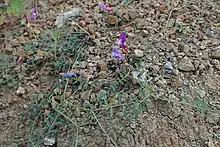| Vicia palaestina | |
|---|---|
 | |
| Close-up of flower | |
 | |
| Habit | |
| Scientific classification | |
| Kingdom: | Plantae |
| Clade: | Tracheophytes |
| Clade: | Angiosperms |
| Clade: | Eudicots |
| Clade: | Rosids |
| Order: | Fabales |
| Family: | Fabaceae |
| Subfamily: | Faboideae |
| Genus: | Vicia |
| Species: | V. palaestina |
| Binomial name | |
| Vicia palaestina | |
| Synonyms[1] | |
| |
Vicia palaestina, the Palestine vetch, is a species of flowering plant in the family Fabaceae. It is native to the eastern Mediterranean region; Greece, the Aegean Islands, Turkey, Cyprus, the Levant, Sinai, and Iraq.[1] Carbonized remains of its seeds have been tentatively identified in Mousterian Neanderthal deposits in Kebara Cave, Mount Carmel, Israel.[2] Unlike many species of vetch, its seeds are non-toxic, and are edible even when raw.[3]
References
- 1 2 "Vicia palaestina Boiss". Plants of the World Online. Royal Botanic Gardens, Kew. Retrieved 6 February 2022.
- ↑ Lev, Efraim; Kislev, Mordechai E.; Bar-Yosef, Ofer (2005). "Mousterian vegetal food in Kebara Cave, Mt. Carmel". Journal of Archaeological Science. 32 (3): 475–484. Bibcode:2005JArSc..32..475L. doi:10.1016/j.jas.2004.11.006.
- ↑ Yeşil, Yeter; Çelik, Mahmut; Yılmaz, Bahattin (2019). "Wild edible plants in Yeşilli (Mardin-Turkey), a multicultural area". Journal of Ethnobiology and Ethnomedicine. 15 (1): 52. doi:10.1186/s13002-019-0327-y. PMC 6833206. PMID 31690334.
This article is issued from Wikipedia. The text is licensed under Creative Commons - Attribution - Sharealike. Additional terms may apply for the media files.